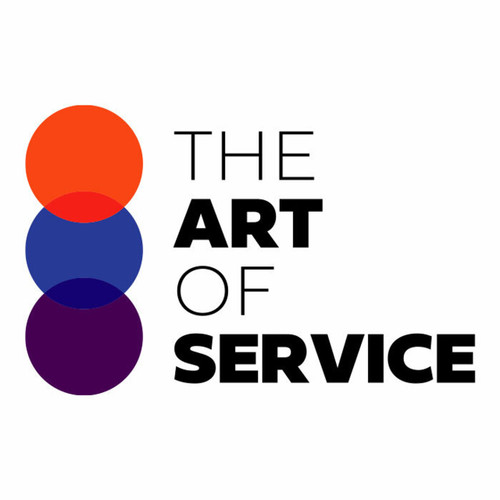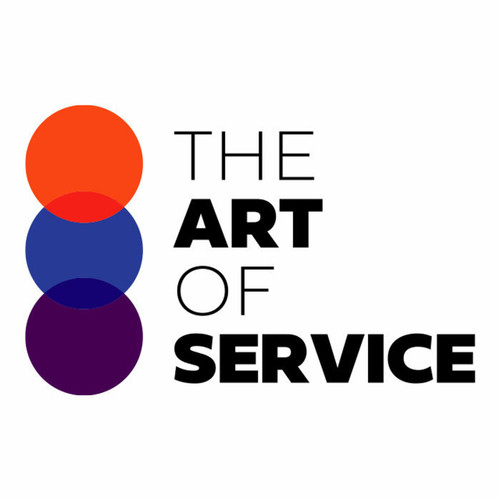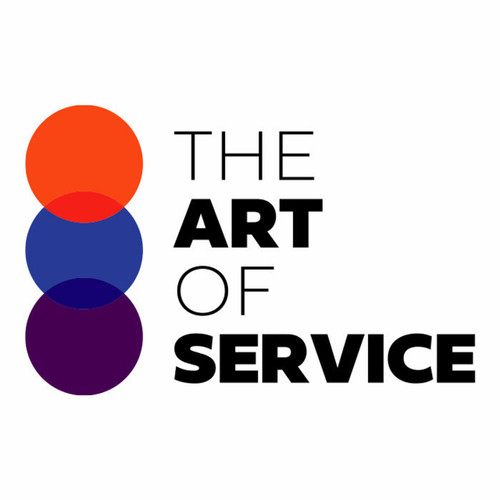Our Procurement Metrics and Indirect Procurement Knowledge Base is here to help.
With 1572 prioritized requirements, our database covers all the essential questions to ask in order to get results by urgency and scope.
But that′s not all, we also provide a comprehensive list of solutions, benefits, and real-life case studies/use cases to help you make informed decisions.
What sets us apart from other procurement databases is our focus on professionals.
Our product type and detailed specifications make it easy for professionals like you to use and understand the data.
And for those looking for an affordable DIY alternative, our Knowledge Base is the perfect solution.
But the benefits don′t stop there.
Our research on Procurement Metrics and Indirect Procurement is continually updated, ensuring you have access to the most current and reliable information.
This means your business can stay ahead of the competition and make strategic decisions based on accurate data.
Speaking of businesses, our Knowledge Base is designed to cater to all types of businesses, big or small.
We understand that procurement is a crucial aspect of any organization, which is why we offer our dataset at an affordable cost.
Say goodbye to expensive consultants and hello to our user-friendly and cost-effective solution.
You may be wondering, what are the pros and cons of our Procurement Metrics and Indirect Procurement Knowledge Base? Well, the pros are endless - from saving time and resources to making more informed and efficient procurement decisions.
As for cons, we′re proud to say there aren′t any.
In a nutshell, our Procurement Metrics and Indirect Procurement Knowledge Base does all the heavy lifting for you, providing you with everything you need to know in one convenient place.
So why wait? Invest in our product today and see the positive impact it can have on your business.
Trust us, you won′t regret it.
Discover Insights, Make Informed Decisions, and Stay Ahead of the Curve:
Key Features:
Comprehensive set of 1572 prioritized Procurement Metrics requirements. - Extensive coverage of 229 Procurement Metrics topic scopes.
- In-depth analysis of 229 Procurement Metrics step-by-step solutions, benefits, BHAGs.
- Detailed examination of 229 Procurement Metrics case studies and use cases.
- Digital download upon purchase.
- Enjoy lifetime document updates included with your purchase.
- Benefit from a fully editable and customizable Excel format.
- Trusted and utilized by over 10,000 organizations.
- Covering: RFP Management, Cost Containment, Contracts Administration, Supplier Consolidation, Strategic Sourcing Implementation, Sourcing Strategy, Procurement Metrics, Supplier Audits, Sourcing Process, Procurement Analytics, Category Strategy, Electronic Invoicing, Supplier Performance Tracking, Global Sourcing, Procurement Best Practices, Low Cost Country Sourcing, Supplier Information Management, Sourcing Models, Sourcing Governance, Supplier Management System, Supply Market Analysis, Invoice Automation, Supplier Feedback, Supplier Relationships, RFQ Process, Outsourcing Strategy, Indirect Procurement, Strategic Sourcing, Sourcing Events, Procurement Success, Expense Management, Sourcing Effectiveness, Category Management, Change Management, Procurement Technology, Business Process Outsourcing, Environmental Impact, Sourcing Intelligence, Procurement Outsourcing, Supplier Portals, Supplier Benchmarking, EDI Implementation, Market Intelligence, Supplier Compliance, Vendor Selection Process, Supplier Performance Management, Spend Under Management, Strategic Partnerships, Procurement Excellence, Procurement And Contracts, Operating Margins, Supplier Segmentation, Project Management For Procurement, Procurement Operations, Market Trends, Technology Strategies, Cost Savings, Invoice Reconciliation, Supplier Monitoring, Sourcing Strategy Implementation, Procurement Consulting, Procurement Goals, Spend Analysis Tools, Supplier Contracts, Procurement Benchmarking, Finance And Procurement Alignment, Category Management Process, Quality Control, Value Analysis, Sourcing Analytics, Site Interpretation, Sourcing Partnerships, Procurement Training, Procurement Performance, Strategic Sourcing Plans, Purchase To Pay, Contract Lifecycle Management, Purchase Requisitions, Supplier Evaluation, Supplier Collaboration, Purchase To Pay Process, Leveraging Technology, Transaction Processing, Inventory Management, Supplier Quality, Vendor Performance Management, Procurement Service Level Agreements, Spend Management, Tail Spend, Supplier Partnerships, Purchasing Strategies, Procurement Communication, Outsourcing Solutions, Supply Chain, Purchase Orders, Procurement Reporting, Invoice Validation, Procurement Contracts Management, Procurement Regulations, Procurement Compliance Management, Market Intelligence Tools, Supplier Market Analysis, Supplier Performance, ERP Procurement Department, Indirect Sourcing and Procurement BPO, Supply Chain Risk Management, Procurement Network, Supplier Surveys, Supply Base Management, Procure To Pay Process, Grid Flexibility, Supplier Databases, Spend Analysis, Travel Procurement, Procurement Policy, Supplier Data Management, Contract Management, Supplier Scorecards, Supplier Negotiations, Savings Tracking, Sourcing Evaluation, Procurement Guidelines, Invoice Verification, Contract Negotiation, Sourcing And Procurement Integration, Procurement Governance, Procurement Efficiency, Risk Management Strategies, Procurement Optimization, Procurement Risk Management, Procurement Software, Service Delivery, Electronic Ordering, Control System Engineering, Supplier Relationships Management, Supplier Performance Scorecards, Benchmarking Analysis, Accounts Payable, Global Procurement, Contract Administration, Procurement Systems, Management Systems, Invoice Exceptions, Contract Review, Procurement Lifecycle, Demand Planning, Procurement Process, Invoice Management, Supplier Onboarding, Vendor Evaluation, Vendor Management Software, Procurement Process Improvement, Cost Reduction, Price Analysis, Supplier Quality Management, Supplier Risk, Dynamic Sourcing, Sourcing Optimization, Procurement Ethics, Supplier Assessment, Business Process Redesign, Performance Metrics, Outsourcing Services, BPO Outsourcing, Supplier Identification, Spend Consolidation, Outsourcing Providers, Spend Visibility, Procurement Audits, Incubator Programs, Procurement Budget, Contract Negotiation Process, Supplier Diversity, Tail Spend Analysis, Management Reporting, Supply Chain Optimization, External Spend Management, Sourcing Solutions, Electronic Invoice Processing, Sustainable Sourcing, Vendor Management, Supplier Negotiation, Managed Spend, Procurement Automation, Procurement Maturity, Commodity Procurement, Invoice Processing Services, Automated Procurement, Negotiation Skills, Data Management, Sourcing Policies, Innovation Procurement, IT Staffing, Cost Optimization, Procurement Audit, Procurement Strategy, Reverse Auction, Indirect Spend Management, Procurement Transformation Strategy, Professional Development, Supplier Communication, Sourcing Strategy Development, Procurement Governance Framework, Sourcing Tools, Expense Management System, RFx Process, Contract Terms, Sustainable Procurement, Contract Compliance, Indirect Cost Reduction, Supplier Onboarding Process, Procurement Policies, Procurement Transformation, Total Cost Of Ownership, Supplier Performance Improvement, Printing Procurement, Sourcing Insights, Corporate Social Responsibility Goals, Total Productive Maintenance, Spend Analysis Software, Supplier Collaboration Tools, Vendor Risk Assessment, Sourcing Platforms, Supplier Due Diligence, Invoice Processing, Sourcing Efficiency, Compliance Management, Supplier Relationship Optimization, Spending Control
Procurement Metrics Assessment Dataset - Utilization, Solutions, Advantages, BHAG (Big Hairy Audacious Goal):
Procurement Metrics
Procurement metrics are used to measure the effectiveness of a company′s procurement process. This includes evaluating factors such as cost savings, supplier performance, and contract compliance. The order of importance of these metrics may vary depending on the organization′s goals and priorities.
1. Cost Savings: Measures the amount of money saved through procurement processes, leading to improved profitability.
2. Supplier Performance: Evaluates the quality of goods and services provided by suppliers, ensuring high standards are maintained.
3. Contract Compliance: Tracks the adherence to contracts and legally binding agreements, reducing the risk of non-compliance.
4. On-time Delivery: Monitors suppliers’ ability to deliver goods and services on time, ensuring timely completion of projects and avoiding delays.
5. Spend Analysis: Examines historical spending patterns to identify cost-saving opportunities and improve future budget planning.
6. Supplier Diversity: Measures the diversity of suppliers used, promoting inclusivity and supporting minority-owned businesses.
7. Purchase Order Cycle Time: Tracks the time taken to process purchase orders, identifying bottlenecks and improving efficiency.
8. Supply Market Intelligence: Analyzes market trends and conditions to inform procurement strategies and decisions.
9. Quality Control: Ensures products and services meet quality standards and customer requirements, preventing rework and additional costs.
10. Customer Satisfaction: Collects feedback from internal stakeholders to assess satisfaction with procurement processes and make improvements.
CONTROL QUESTION: What specific metrics are used to evaluate the performance and what is the order of importance?
Big Hairy Audacious Goal (BHAG) for 10 years from now:
Big Hairy Audacious Goal:
By 2030, Procurement Metrics will be recognized as the leading provider of performance evaluation metrics for procurement teams worldwide, driving significant cost savings and efficiency improvements for organizations of all sizes and industries.
Specific Metrics:
1. Cost Savings: This metric will track the overall cost savings achieved by procurement efforts, including negotiated savings, contract renegotiations, and cost avoidance.
2. Supplier Performance: The success of procurement efforts relies heavily on the performance of suppliers. This metric will measure factors such as on-time delivery, quality of goods and services, and responsiveness to issues or concerns.
3. Contract Compliance: This metric will evaluate how well procurement teams are adhering to contractual agreements, ensuring that all terms and conditions are met.
4. Spend under Management: This metric will track the percentage of total spend that is actively managed by the procurement team, providing insight into the effectiveness of procurement processes and strategies.
5. Supplier Diversity: In today′s global marketplace, diversity in supplier selection is essential. This metric will measure the percentage of spend with diverse suppliers, such as minority-owned or women-owned businesses.
6. Time to Contract: This metric will evaluate the speed and efficiency of the procurement process, from the initial request for proposal to final contract execution.
7. Procure-to-Pay Cycle Time: This metric measures the time it takes for a purchase to be initiated, approved, and paid for. A shorter cycle time indicates a more efficient and streamlined procurement process.
Order of Importance:
The order of importance for these metrics may vary depending on the organization′s goals and priorities. However, overall cost savings and supplier performance should be given the highest importance, as they directly impact the bottom line and the quality of goods and services received. Contract compliance and spend under management should also be given high priority, as they contribute to cost savings and efficient procurement processes. Supplier diversity, time to contract, and procure-to-pay cycle time may have slightly lower importance, but are still crucial components of effective procurement metrics.
Customer Testimonials:
"The prioritized recommendations in this dataset have exceeded my expectations. It`s evident that the creators understand the needs of their users. I`ve already seen a positive impact on my results!"
"The customer support is top-notch. They were very helpful in answering my questions and setting me up for success."
"The range of variables in this dataset is fantastic. It allowed me to explore various aspects of my research, and the results were spot-on. Great resource!"
Procurement Metrics Case Study/Use Case example - How to use:
Introduction:
Procurement is a critical function in any organization as it involves the sourcing of goods and services to meet the organization′s needs. Procurement metrics are essential for evaluating the performance of the procurement function. These metrics provide valuable insights into the effectiveness and efficiency of the procurement process, helping organizations identify areas for improvement and make data-driven decisions. In this case study, we will analyze the specific metrics used to evaluate the performance of the procurement function and their order of importance for a client organization.
Client Situation:
The client is a large multinational organization with operations in multiple countries and a complex procurement process. The organization has a global procurement team responsible for managing the procurement of goods and services for all its business units. However, the organization was facing challenges in measuring the performance of its procurement function. They lacked a standardized metric system and had no clear understanding of which metrics were most critical in evaluating their procurement performance. This lack of clarity made it difficult for the organization to identify areas for improvement and make informed decisions.
Consulting Methodology:
Our consulting approach involved a thorough analysis of the organization′s current procurement process, including data collection, process mapping, and interviews with key stakeholders. We also conducted a benchmarking exercise to compare the organization′s procurement metrics against industry standards and best practices. Based on our findings, we recommended a set of procurement metrics that would provide a comprehensive view of the organization′s procurement performance.
Deliverables:
Our deliverables included a detailed report outlining our findings and recommendations, along with a customized dashboard to track and monitor the identified metrics. We also provided training to the procurement team on how to use the dashboard effectively to evaluate their performance.
Implementation Challenges:
The implementation of the new procurement metrics posed several challenges, including resistance to change and a lack of data quality. Some stakeholders were hesitant to adopt the new metrics, as they were used to the old ones and feared that they might be held accountable for poor performance. Additionally, the organization faced challenges in ensuring data accuracy and consistency as there were multiple systems and processes involved in the procurement function.
Key Performance Indicators (KPIs):
1. Cost Savings: The cost savings metric measures the amount of money saved by the procurement function through negotiations, competitive bidding, and other cost-saving measures. This is a crucial KPI for the organization as it directly affects the bottom line.
2. Supplier Performance: This metric evaluates the performance of the organization′s suppliers, including on-time delivery, quality of goods and services, and overall customer satisfaction. A good supplier performance metric helps the organization identify its top-performing suppliers and those that need improvement.
3. Cycle Time: The cycle time metric measures the time taken from when a requisition is raised to when the goods or services are delivered. A lower cycle time indicates an efficient procurement process, while a longer cycle time can lead to delays, which can negatively impact the organization′s operations.
4. Contract Compliance: Contract compliance measures the extent to which suppliers comply with the terms and conditions outlined in their contracts. Adherence to contracts is crucial for effective supplier management, cost control, and risk management.
5. Procurement Spend by Category: This metric breaks down the organization′s procurement spend by different categories such as direct vs. indirect spend, commodity type, and supplier type. This provides valuable insights into the organization′s spending patterns and helps identify areas where cost-saving measures can be implemented.
Order of Importance:
While all of the above metrics are essential for evaluating procurement performance, the order of importance may vary depending on the organization′s objectives and priorities. However, in our experience, the most critical metric for evaluating procurement performance is cost savings followed by supplier performance, cycle time, contract compliance, and procurement spend by category.
Management Considerations:
To effectively use procurement metrics for performance evaluation, organizations must consider the following:
1. Establish Targets: Each metric should have a target or benchmark for the organization to strive towards. These targets should be realistic and aligned with the organization′s overall objectives.
2. Timely Reporting: Regular reporting of procurement metrics is crucial for effective performance management. Organizations should establish a reporting cadence and ensure that the data is accurate and up-to-date.
3. Continuous Improvement: Metrics serve as a benchmark for identifying areas of improvement. Organizations must use the insights from these metrics to implement process improvements and continuously strive for better performance.
Conclusion:
In conclusion, procurement metrics are an essential tool for evaluating the performance of the procurement function. The specific metrics used may vary depending on the organization′s objectives and priorities, but cost savings, supplier performance, cycle time, contract compliance, and procurement spend by category are some of the most critical metrics. By implementing a standardized metric system and regularly monitoring these metrics, organizations can improve the efficiency and effectiveness of their procurement process, leading to cost savings and improved supplier management.
Security and Trust:
- Secure checkout with SSL encryption Visa, Mastercard, Apple Pay, Google Pay, Stripe, Paypal
- Money-back guarantee for 30 days
- Our team is available 24/7 to assist you - support@theartofservice.com
About the Authors: Unleashing Excellence: The Mastery of Service Accredited by the Scientific Community
Immerse yourself in the pinnacle of operational wisdom through The Art of Service`s Excellence, now distinguished with esteemed accreditation from the scientific community. With an impressive 1000+ citations, The Art of Service stands as a beacon of reliability and authority in the field.Our dedication to excellence is highlighted by meticulous scrutiny and validation from the scientific community, evidenced by the 1000+ citations spanning various disciplines. Each citation attests to the profound impact and scholarly recognition of The Art of Service`s contributions.
Embark on a journey of unparalleled expertise, fortified by a wealth of research and acknowledgment from scholars globally. Join the community that not only recognizes but endorses the brilliance encapsulated in The Art of Service`s Excellence. Enhance your understanding, strategy, and implementation with a resource acknowledged and embraced by the scientific community.
Embrace excellence. Embrace The Art of Service.
Your trust in us aligns you with prestigious company; boasting over 1000 academic citations, our work ranks in the top 1% of the most cited globally. Explore our scholarly contributions at: https://scholar.google.com/scholar?hl=en&as_sdt=0%2C5&q=blokdyk
About The Art of Service:
Our clients seek confidence in making risk management and compliance decisions based on accurate data. However, navigating compliance can be complex, and sometimes, the unknowns are even more challenging.
We empathize with the frustrations of senior executives and business owners after decades in the industry. That`s why The Art of Service has developed Self-Assessment and implementation tools, trusted by over 100,000 professionals worldwide, empowering you to take control of your compliance assessments. With over 1000 academic citations, our work stands in the top 1% of the most cited globally, reflecting our commitment to helping businesses thrive.
Founders:
Gerard Blokdyk
LinkedIn: https://www.linkedin.com/in/gerardblokdijk/
Ivanka Menken
LinkedIn: https://www.linkedin.com/in/ivankamenken/







